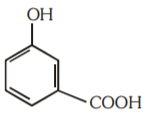Which of the following acid will form an (a) Anhydride on heating and
(b) Acid amide on strong heating with ammonia?




The correct Answer is:A
To solve the question, we need to identify an acid that can form an anhydride when heated and can also form an acid amide when heated with ammonia. Let's break down the solution step by step.
Step 1: Understand the Formation of Anhydrides
An anhydride is formed from carboxylic acids when two carboxylic acid groups (–COOH) are adjacent to each other. Upon heating, these groups can lose a molecule of water (H₂O) to form the anhydride.
Hint: Look for carboxylic acids with adjacent –COOH groups for anhydride formation.
Step 2: Identify the Acid for Anhydride Formation
Consider common dicarboxylic acids like acetic acid (CH₃COOH) or oxalic acid (HOOC-COOH). The latter has two –COOH groups that are adjacent. When heated, oxalic acid can lose water and form oxalic anhydride.
Hint: Check for dicarboxylic acids that can lose water upon heating.
Step 3: Understand the Formation of Acid Amides
An acid amide is formed when a carboxylic acid reacts with ammonia (NH₃). Strong heating typically promotes this reaction, leading to the formation of an amide (RCONH₂) and the release of water.
Hint: Look for a reaction between a carboxylic acid and ammonia to form an amide.
Step 4: Identify the Acid for Amide Formation
Using acetic acid as an example, when it is heated with excess ammonia, it can form acetamide (CH₃CONH₂) and release water. This reaction is favorable under strong heating conditions.
Hint: Consider simple carboxylic acids that can react with ammonia to form amides.
Step 5: Conclusion
Based on the analysis, the acid that meets both criteria (forming an anhydride upon heating and forming an acid amide with ammonia) is oxalic acid.
Thus, the answer to the question is:
- (a) Oxalic acid forms an anhydride on heating.
- (b) Oxalic acid can also form an acid amide when heated with ammonia.
Final Answer
The correct acid is oxalic acid.
An anhydride is formed from carboxylic acids when two carboxylic acid groups (–COOH) are adjacent to each other. Upon heating, these groups can lose a molecule of water (H₂O) to form the anhydride.
Consider common dicarboxylic acids like acetic acid (CH₃COOH) or oxalic acid (HOOC-COOH). The latter has two –COOH groups that are adjacent. When heated, oxalic acid can lose water and form oxalic anhydride.
An acid amide is formed when a carboxylic acid reacts with ammonia (NH₃). Strong heating typically promotes this reaction, leading to the formation of an amide (RCONH₂) and the release of water.
Using acetic acid as an example, when it is heated with excess ammonia, it can form acetamide (CH₃CONH₂) and release water. This reaction is favorable under strong heating conditions.
Based on the analysis, the acid that meets both criteria (forming an anhydride upon heating and forming an acid amide with ammonia) is oxalic acid.
- (a) Oxalic acid forms an anhydride on heating.
- (b) Oxalic acid can also form an acid amide when heated with ammonia.
The correct acid is oxalic acid.
Similar Questions
Knowledge Check
Which of the following oxides is an anhydride of nitrous acid?
AN2O3BNO2CNODN2O4Which of the following compounds will not give ammonia on heating?
A(NH4)2SO4BNH2CONH2CNH4NO2DNH4ClWhich of the following is not an acid anhydride ?
A B
B C
C D
D
Which of the following is a nitric acid anhydride?
View SolutionWhich of the following acid remains unaffected on heating ?
View SolutionWhich of the following tetracarboxylic acid form di-anhydride :
View SolutionWhich one of the following is a strong acid?
View SolutionWhich of the following products is formed when adipic acid is heated ?
View Solution
